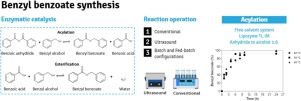当前位置:
X-MOL 学术
›
Process Biochem.
›
论文详情
Our official English website, www.x-mol.net, welcomes your feedback! (Note: you will need to create a separate account there.)
Enzymatic synthesis of benzyl benzoate using different acyl donors: Comparison of solvent-free reaction techniques
Process Biochemistry ( IF 3.7 ) Pub Date : 2020-05-01 , DOI: 10.1016/j.procbio.2020.01.018 Alessandra Cristina de Meneses , Manuela Balen , Elaine de Andrade Jasper , Ilka Korte , Pedro Henrique Hermes de Araújo , Claudia Sayer , Débora de Oliveira
Process Biochemistry ( IF 3.7 ) Pub Date : 2020-05-01 , DOI: 10.1016/j.procbio.2020.01.018 Alessandra Cristina de Meneses , Manuela Balen , Elaine de Andrade Jasper , Ilka Korte , Pedro Henrique Hermes de Araújo , Claudia Sayer , Débora de Oliveira

|
Abstract In this study, benzyl benzoate was successfully synthesized via enzymatic acylation using three immobilized enzymes as biocatalysts. Different acyl donors (benzoic acid and benzoic anhydride), operation regimes (batch, fed-batch), mixing modes (conventional mechanical stirring and ultrasound), process parameters (temperature, substrate molar ratio of acyl donor to acyl acceptor), presence or absence of solvents, enzyme amount and type were evaluated. Benzoic acid is a solid that is difficult to solubilize and, thus, was not efficient as acyl donor for the synthesis of benzyl benzoate. On the other hand, benzoic anhydride was very effective for the acylation of benzyl benzoate, and the presence of an excess of benzyl alcohol was essential to ensure the solute-solvent intermolecular attractions and good substrate solubilization, allowing the ester synthesis to be performed in the absence of organic solvents. The ultrasound was effective in increasing increase the initial reaction rate and the final conversion (88 %). However, the Lipozyme TL-IM and RM-IM supports were damaged, and the reuse was unfeasible. The batch and fed-batch approaches in conventional stirring ensured high conversions of 92 and 90 %, respectively, for batch (anhydride: alcohol 1:6) and fed-batch (1:3) using the Lipozyme TL-IM as biocatalyst. The controlled addition of the anhydride (fed-batch) allowed the reduction of alcohol molar ratio but decreased the reaction rates, and the maximum conversions were reached only after 24 h, while the batch approach had 92 % of conversion after 6 h. The yield of benzyl benzoate was high at 6 wt.% of enzyme, low temperature (50 °C), and simple reactor operation (batch). Results show the feasibility of the synthesis of benzyl benzoate via acylation using a green process that may be an alternative route to the chemical synthesis.
中文翻译:

使用不同酰基供体酶法合成苯甲酸苄酯:无溶剂反应技术的比较
摘要 本研究以三种固定化酶为生物催化剂,通过酶促酰化反应成功合成苯甲酸苄酯。不同的酰基供体(苯甲酸和苯甲酸酐)、操作方式(分批、补料分批)、混合模式(常规机械搅拌和超声)、工艺参数(温度、酰基供体与酰基受体的底物摩尔比)、存在与否溶剂、酶量和类型进行评估。苯甲酸是一种难以溶解的固体,因此不能有效地作为合成苯甲酸苄酯的酰基供体。另一方面,苯甲酸酐对苯甲酸苄酯的酰化非常有效,过量苯甲醇的存在对于确保溶质-溶剂分子间吸引力和良好的底物溶解性至关重要,允许在不存在有机溶剂的情况下进行酯合成。超声可有效提高初始反应速率和最终转化率 (88%)。然而,Lipozyme TL-IM 和 RM-IM 支架已损坏,无法重复使用。对于使用 Lipozyme TL-IM 作为生物催化剂的分批(酸酐:醇 1:6)和分批补料(1:3),常规搅拌中的分批和补料分批方法分别确保了 92% 和 90% 的高转化率。酸酐的受控添加(补料分批)允许降低醇摩尔比但降低反应速率,并且仅在 24 小时后达到最大转化率,而分批方法在 6 小时后转化率为 92%。苯甲酸苄酯的产率很高,酶的重量百分比为 6%,低温(50°C),和简单的反应器操作(批量)。结果表明使用绿色工艺通过酰化合成苯甲酸苄酯的可行性,这可能是化学合成的替代途径。
更新日期:2020-05-01
中文翻译:

使用不同酰基供体酶法合成苯甲酸苄酯:无溶剂反应技术的比较
摘要 本研究以三种固定化酶为生物催化剂,通过酶促酰化反应成功合成苯甲酸苄酯。不同的酰基供体(苯甲酸和苯甲酸酐)、操作方式(分批、补料分批)、混合模式(常规机械搅拌和超声)、工艺参数(温度、酰基供体与酰基受体的底物摩尔比)、存在与否溶剂、酶量和类型进行评估。苯甲酸是一种难以溶解的固体,因此不能有效地作为合成苯甲酸苄酯的酰基供体。另一方面,苯甲酸酐对苯甲酸苄酯的酰化非常有效,过量苯甲醇的存在对于确保溶质-溶剂分子间吸引力和良好的底物溶解性至关重要,允许在不存在有机溶剂的情况下进行酯合成。超声可有效提高初始反应速率和最终转化率 (88%)。然而,Lipozyme TL-IM 和 RM-IM 支架已损坏,无法重复使用。对于使用 Lipozyme TL-IM 作为生物催化剂的分批(酸酐:醇 1:6)和分批补料(1:3),常规搅拌中的分批和补料分批方法分别确保了 92% 和 90% 的高转化率。酸酐的受控添加(补料分批)允许降低醇摩尔比但降低反应速率,并且仅在 24 小时后达到最大转化率,而分批方法在 6 小时后转化率为 92%。苯甲酸苄酯的产率很高,酶的重量百分比为 6%,低温(50°C),和简单的反应器操作(批量)。结果表明使用绿色工艺通过酰化合成苯甲酸苄酯的可行性,这可能是化学合成的替代途径。
















































 京公网安备 11010802027423号
京公网安备 11010802027423号